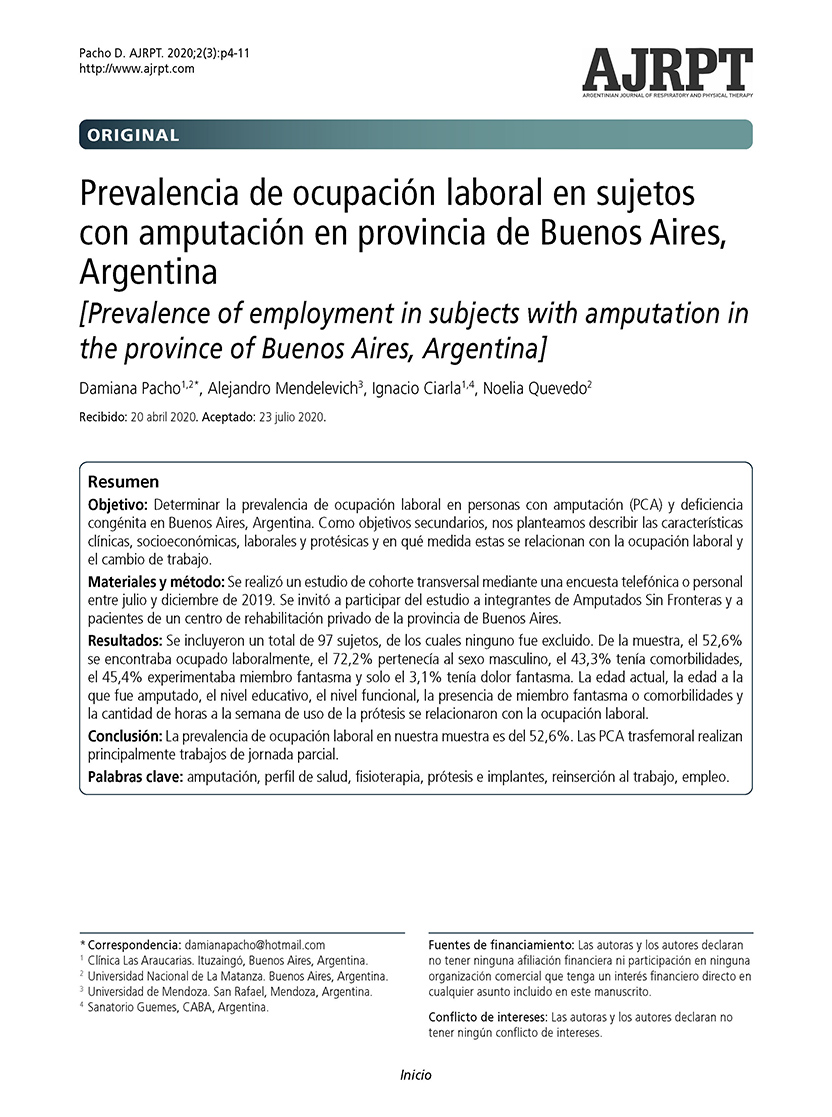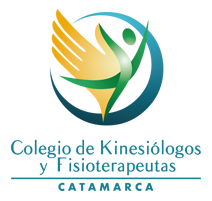Prevalencia de ocupación laboral en sujetos con amputación en provincia de Buenos Aires, Argentina
DOI:
https://doi.org/10.58172/ajrpt.v2i3.103Palabras clave:
perfil de salud, fisioterapia, prótesis e implantes, empleo, reinsercion al trabajo, amputaciónResumen
Objetivo: Determinar la prevalencia de ocupación laboral en personas con amputación (PCA) y deficiencia congénita en Buenos Aires, Argentina. Como objetivos secundarios, nos planteamos describir las características clínicas, socioeconómicas, laborales y protésicas y en qué medida estas se relacionan con la ocupación laboral y el cambio de trabajo.
Materiales y método: Se realizó un estudio de cohorte transversal mediante una encuesta telefónica o personal entre julio y diciembre de 2019. Se invitó a participar del estudio a integrantes de Amputados Sin Fronteras y a pacientes de un centro de rehabilitación privado de la provincia de Buenos Aires.
Resultados: Se incluyeron un total de 97 sujetos, de los cuales ninguno fue excluido. De la muestra, el 52,6% se encontraba ocupado laboralmente, el 72,2% pertenecía al sexo masculino, el 43,3% tenía comorbilidades, el 45,4% experimentaba miembro fantasma y solo el 3,1% tenía dolor fantasma. La edad actual, la edad a la que fue amputado, el nivel educativo, el nivel funcional, la presencia de miembro fantasma o comorbilidades y la cantidad de horas a la semana de uso de la prótesis se relacionaron con la ocupación laboral.
Conclusión: La prevalencia de ocupación laboral en nuestra muestra es del 52,6%. Las PCA trasfemoral realizan principalmente trabajos de jornada parcial.
Descargas
Citas
Marconi EH. Egresos de establecimiento oficiales según variables seleccionadas [Internet] http://www.deis.msal.gov.ar/wp-content/uploads/2016/01/Serie12Nro4.pdf: Ministerio De Salud De La Nación; 2003 [updated 24/04/2018Cited: 11/04/2020].
McGuirk CK, Westgate MN, Holmes LB. Limb deficiencies in newborn infants. Pediatrics. 2001;108(4):E64.
Alvial P, Solis F, Espinoza MJ, Alvaro M, San Martin P. Prevalencia de inserción laboral en la adultez de pacientes amputados antes de los 18 años. Rehabil integral. 2014;9(1):9.
Nelson VS, Flood KM, Bryant PR, Huang ME, Pasquina PF, Roberts TL. Limb deficiency and prosthetic management. 1. Decision making in prosthetic prescription and management. Arch Phys Med Rehabil. 2006;87(3 Suppl 1):S3-9.
Aas RW, Haveraaen LA, Brouwers EPM, Skarpaas LS. Who among patients with acquired brain injury returned to work after occupational rehabilitation? The rapid-return-to-work-cohort-study. Disabil Rehabil. 2018;40(21):2561-70.
Ost Nilsson A, Eriksson G, Johansson U, Hellman T. Experiences of the return to work process after stroke while participating in a person-centred rehabilitation programme. Scand J Occup Ther. 2017;24(5):349-56.
Hilton G, Unsworth C, Murphy G. The experience of attempting to return to work following spinal cord injury: a systematic review of the qualitative literature. Disabil Rehabil. 2018;40(15):1745-53.
De Boer AG, Taskila TK, Tamminga SJ, Feuerstein M, Frings-Dresen MH, Verbeek JH. Interventions to enhance return-to-work for cancer patients. Cochrane Database Syst Rev. 2015(9):CD007569.
Boynton B. The rehabilitation and the re-employment potential of the amputee. American Journal of Surgery. 1955;89:924-31.
van der Sluis CK, Hartman PP, Schoppen T, Dijkstra PU. Job adjustments, job satisfaction and health experience in upper and lower limb amputees. Prosthet Orthot Int. 2009;33(1):41-51.
Ide M, Obayashi T, Toyonaga T. Association of pain with employment status and satisfaction among amputees in Japan. Arch Phys Med Rehabil. 2002;83(10):1394-8.
Schoppen T, Boonstra A, Groothoff JW, de Vries J, Goeken LN, Eisma WH. Employment status, job characteristics, and work-related health experience of people with a lower limb amputation in The Netherlands. Arch Phys Med Rehabil. 2001;82(2):239-45.
Schoppen T, Boonstra A, Groothoff JW, van Sonderen E, Goeken LN, Eisma WH. Factors related to successful job reintegration of people with a lower limb amputation. Arch Phys Med Rehabil. 2001;82(10):1425-31.
Millstein S, Bain D, Hunter GA. A review of employment patterns of industrial amputees factors influencing rehabilitation. Prosthetics and Orthotics International. 1985; 9:69-78.
Muniesa-Portolés JM, Cabra-Martorell M, Samsó-Bardés F. Reincorporación laboral en pacientes con amputación traumática de extremidad superior. Rehabilitación. 2011;45(2):134-8.
Czerniecki JM, Turner AP, Williams RM, Hakimi KN, Norvell DC. Mobility changes in individuals with dysvascular amputation from the presurgical period to 12 months postamputation. Arch Phys Med Rehabil. 2012;93(10):1766-73.
Mendelevich A, Kramer M, Maiarú M, Modica M, Ostolaza M, Peralta F. Sujetos con amputaciones en la Ciudad de Buenos Aires. Estudio epidemiológico de cinco años. Medicina (Buenos Aires). 2015;75:384-6.
Radhakrishnan S, Kohler F, Gutenbrunner C, Jayaraman A, Li J, Pieber K, et al. The use of the International Classification of Functioning, Disability and Health to classify the factors influencing mobility reported by persons with an amputation: An international study. Prosthet Orthot Int. 2017;41(4):412-9.
Schoppen T, Boonstra A, Groothoff JW, De Vries J, Goeken LN, Eisma WH. Job satisfaction and health experience of people with a lower-limb amputation in comparison with healthy colleagues. Arch Phys Med Rehabil. 2002;83(5):628-34.
Gailey RS, Roach KE, Applegate EB, Cho B, Cunniffe B, Licht S, et al. The Amputee Mobility Predictor: An instrument to assess determinants of the lower-limb amputee's ability to ambulate. Archives of Physical Medicine and Rehabilitation. 2002;83(5):613-27.
Ley de Contrato de Trabajo, LEY N° 20.744. Sect. InfoLeg (1976).
Manzano GL, Duclós S. Trabajo e ingresos. Vol. 3, nº 7 Mercado de trabajo. Tasas e indicadores socioeconómicos [Internet] https://www.indec.gob.ar/uploads/informesdeprensa/mercado_trabajo_eph_3trim19BCC9AAAD16.pdf: Instituto Nacional de Estadística y Censos; 2019 [updated 12-2019;Cited 02-02-2020].
Whyte AD, Carrol LJ. A preliminary examination of the relationship between employment, pain and disability in anamputee population. Disability and Rehabilitation. 2002;24(9):462-70.
Esquenazi A, Roberts M. Rehabilitation in limb deficiency. 4. Limb amputation. Arch Phys Med Rehabil. 1996;77:18-28.
Fernandez A, Isusi I, Gomez M. Factors conditioning the return to work of upper limb amputees in Asturias, Spain. Prosthetics and Orthotics International. 2000;24:143-7.

Archivos adicionales
Publicado
Cómo citar
Número
Sección
Licencia
Los autores/as que publiquen en esta revista aceptan las siguientes condiciones:
- Los autores conservan todos los derechos morales y patrimoniales de sus obras, cediendo solamente a la AJRPT el derecho a la primera publicación de éste. En consecuencia, los autores pueden realizar otros acuerdos contractuales independientes y adicionales para la distribución del artículo o texto.
- Los autores/as conservarán sus derechos de autor y aceptan la licencia de distribución de AJRPT, la cuál es Licencia de Reconocimiento - Compartir Igual Creative Commons.
- Los autores/as pueden realizar otros acuerdos contractuales independientes y adicionales para la distribución de la versión del artículo publicado en esta revista (p. ej., incluirlo en un repositorio institucional o publicarlo en un libro) siempre que indiquen claramente que el trabajo se publicó por primera vez en esta revista.
- Se permite y recomienda a los autores/as a publicar su trabajo en Internet (por ejemplo, en páginas institucionales o personales) sólo una vez que sean publicados en la revista AJRPT, ya que puede conducir a intercambios productivos y a una mayor y más rápida difusión.

Este obra está bajo una licencia de Creative Commons Reconocimiento-CompartirIgual 4.0 Internacional.




















